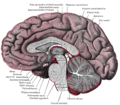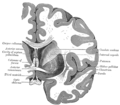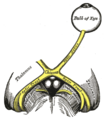Optic chiasm: Difference between revisions
correct spelling and give lexical form of root word |
+polytonic templates |
||
| Line 19: | Line 19: | ||
DorlandsSuf = | |
DorlandsSuf = | |
||
}} |
}} |
||
The '''optic chiasm''' ([[Greek language|Greek]] χίασμα, "crossing", from the Greek χιαζω 'to mark with an X', after the Greek letter '[[Chi (letter)|Χ]]', ''chi'') is the part of the [[brain]] where the [[optic nerve]]s partially cross. |
The '''optic chiasm''' ([[Greek language|Greek]] {{polytonic|χίασμα}}, "crossing", from the Greek {{polytonic|χιαζω}} 'to mark with an X', after the Greek letter '[[Chi (letter)|Χ]]', ''chi'') is the part of the [[brain]] where the [[optic nerve]]s partially cross. |
||
==Pathways== |
==Pathways== |
||
Revision as of 21:24, 13 February 2009
| Optic chiasm | |
|---|---|
 Visual pathway with optic chiasm (X shape outlined, red) (1543 image from Andreas Vesalius' Fabrica) | |
| Details | |
| Identifiers | |
| Latin | chiasma opticum |
| MeSH | D009897 |
| NeuroNames | 459 |
| NeuroLex ID | birnlex_1416 |
| TA98 | A14.1.08.403 |
| TA2 | 5668 |
| FMA | 62045 |
| Anatomical terms of neuroanatomy | |
The optic chiasm (Greek χίασμα, "crossing", from the Greek χιαζω 'to mark with an X', after the Greek letter 'Χ', chi) is the part of the brain where the optic nerves partially cross.
Pathways
Specifically, in the optic chiasm, the nerves connected to the right eye that attend to the right temporal visual field (located in the right retina) cross to the left half of the brain, while the nerves from the left eye that attend to the left temporal visual field (located in the left retina) cross to the right half of the brain.
This allows for parts of both eyes that attend to the right visual field to be processed in the left visual system in the brain, and vice versa.
Optic chiasm in cats
In Siamese cats with certain genotypes of the albino gene, this wiring is disrupted, with less of the nerve-crossing than is normal, as a number of scholars have reported. [1] To compensate for lack of crossing in their brains, they cross their eyes (strabismus). [2]
This is also seen in albino tigers, as Guillery & Kaas report.[3]
Additional images
-
Mesal aspect of a brain sectioned in the median sagittal plane.
-
Median sagittal section of brain.
-
Scheme showing central connections of the optic nerves and optic tracts.
-
Base of brain.
-
Coronal section of brain through anterior commissure.
-
The fornix and corpus callosum from below.
-
Diagram showing the positions of the three principal subarachnoid cisternæ.
-
The left optic nerve and the optic tracts.
-
The hypophysis cerebri in position. Shown in sagittal section.
-
Median sagittal through the hypophysis of an adult monkey. Semidiagrammatic.
-
3D schematic representation of optic tracts
-
Human brainstem anterior view
See also
References
- Jeffery, Glen. Architecture of the Optic Chiasm and the Mechanisms That Sculpt Its Development Physiol Rev, Oct 2001; 81: 1393 - 1414.












